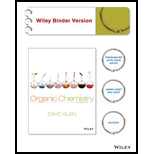
(a)
Interpretation:
Name for given compounds should be identified.
Concept introduction:
The Haworth projection: A Haworth projection is a three-dimensional representation of monosaccharides and the structural formula is inscription as a cyclic structures.
In Haworth projection, oxygen atom is placed in back right corner,
Fischer Projection: The orientation of the carbon atoms in a molecule is arranged vertically from top to bottom.
The C1 carbon is at the top of the orientation, the hydrogen and hydroxyl groups are placed in right and left side of the orientation. D and L form are depends on the arrangement of the hydroxyl group. If the hydroxyl group is in the right side of the molecule in the penultimate (next-to-last) carbon is called as D sugar, if the If the hydroxyl group is in the left side of the molecule in the penultimate (next-to-last) carbon is called as L sugar.
Pyranose: A six-member cyclic form of a monosaccharide is called as pyronose.
(b)
Interpretation:
Name for given compounds should be identified.
Concept introduction:
The Haworth projection: A Haworth projection is a three-dimensional representation of monosaccharides and the structural formula is inscription as a cyclic structures.
In Haworth projection, oxygen atom is placed in back right corner,
Fischer Projection: The orientation of the carbon atoms in a molecule is arranged vertically from top to bottom.
The C1 carbon is at the top of the orientation, the hydrogen and hydroxyl groups are placed in right and left side of the orientation. D and L form are depends on the arrangement of the hydroxyl group. If the hydroxyl group is in the right side of the molecule in the penultimate (next-to-last) carbon is called as D sugar, if the If the hydroxyl group is in the left side of the molecule in the penultimate (next-to-last) carbon is called as L sugar.
Pyranose: A six-member cyclic form of a monosaccharide is called as pyronose.
To find: Open chain form of given molecule.
(c)
Interpretation:
Name for given compounds should be identified.
Concept introduction:
The Haworth projection: A Haworth projection is a three-dimensional representation of monosaccharides and the structural formula is inscription as a cyclic structures.
In Haworth projection, oxygen atom is placed in back right corner,
Fischer Projection: The orientation of the carbon atoms in a molecule is arranged vertically from top to bottom.
The C1 carbon is at the top of the orientation, the hydrogen and hydroxyl groups are placed in right and left side of the orientation. D and L form are depends on the arrangement of the hydroxyl group. If the hydroxyl group is in the right side of the molecule in the penultimate (next-to-last) carbon is called as D sugar, if the If the hydroxyl group is in the left side of the molecule in the penultimate (next-to-last) carbon is called as L sugar.
Pyranose: A six-member cyclic form of a monosaccharide is called as pyronose.
To find: Open chain form of given molecule.
Want to see the full answer?
Check out a sample textbook solution
Chapter 24 Solutions
Organic Chemistry, Binder Ready Version
- Identify and provide an explanation that distinguishes a qualitative and quantitative chemical analysis. Provide examples.arrow_forwardIdentify and provide an explanation of the operational principles behind a Atomic Absorption Spectrometer (AAS). List the steps involved.arrow_forwardInstructions: Complete the questions in the space provided. Show all your work 1. You are trying to determine the rate law expression for a reaction that you are completing at 25°C. You measure the initial reaction rate and the starting concentrations of the reactions for 4 trials. BrO³¯ (aq) + 5Br¯ (aq) + 6H* (aq) → 3Br₂ (l) + 3H2O (l) Initial rate Trial [BrO3] [H*] [Br] (mol/L) (mol/L) | (mol/L) (mol/L.s) 1 0.10 0.10 0.10 8.0 2 0.20 0.10 0.10 16 3 0.10 0.20 0.10 16 4 0.10 0.10 0.20 32 a. Based on the above data what is the rate law expression? b. Solve for the value of k (make sure to include proper units) 2. The proposed reaction mechanism is as follows: i. ii. BrО¸¯ (aq) + H+ (aq) → HBrO3 (aq) HBrO³ (aq) + H* (aq) → H₂BrO3* (aq) iii. H₂BrO³* (aq) + Br¯ (aq) → Br₂O₂ (aq) + H2O (l) [Fast] [Medium] [Slow] iv. Br₂O₂ (aq) + 4H*(aq) + 4Br(aq) → 3Br₂ (l) + H2O (l) [Fast] Evaluate the validity of this proposed reaction. Justify your answer.arrow_forward
- a. H3C CH3 H, 1.0 equiv. Br2arrow_forwardH3C. H3C CH 3 CH 3 CH3 1. LDA 2. PhSeCl 3. H2O2arrow_forwardPlease predict the products for each of the following reactions: 1.03 2. H₂O NaNH, 1. n-BuLi 2. Mel A H₂ 10 9 0 H2SO4, H₂O HgSO4 Pd or Pt (catalyst) B 9 2 n-BuLi ♡ D2 (deuterium) Lindlar's Catalyst 1. NaNH2 2. EtBr Na, ND3 (deuterium) 2. H₂O2, NaOH 1. (Sia)2BH с Darrow_forward
- in the scope of ontario SCH4U grade 12 course, please show ALL workarrow_forwardIs the chemical reaction CuCl42-(green) + 4H2O <==> Cu(H2O)42+(blue) + 4Cl- exothermic or endothermic?arrow_forwardIf we react tetraethoxypropane with hydrazine, what is the product obtained (explain its formula). State the reason why the corresponding dialdehyde is not used.arrow_forward
 ChemistryChemistryISBN:9781305957404Author:Steven S. Zumdahl, Susan A. Zumdahl, Donald J. DeCostePublisher:Cengage Learning
ChemistryChemistryISBN:9781305957404Author:Steven S. Zumdahl, Susan A. Zumdahl, Donald J. DeCostePublisher:Cengage Learning ChemistryChemistryISBN:9781259911156Author:Raymond Chang Dr., Jason Overby ProfessorPublisher:McGraw-Hill Education
ChemistryChemistryISBN:9781259911156Author:Raymond Chang Dr., Jason Overby ProfessorPublisher:McGraw-Hill Education Principles of Instrumental AnalysisChemistryISBN:9781305577213Author:Douglas A. Skoog, F. James Holler, Stanley R. CrouchPublisher:Cengage Learning
Principles of Instrumental AnalysisChemistryISBN:9781305577213Author:Douglas A. Skoog, F. James Holler, Stanley R. CrouchPublisher:Cengage Learning Organic ChemistryChemistryISBN:9780078021558Author:Janice Gorzynski Smith Dr.Publisher:McGraw-Hill Education
Organic ChemistryChemistryISBN:9780078021558Author:Janice Gorzynski Smith Dr.Publisher:McGraw-Hill Education Chemistry: Principles and ReactionsChemistryISBN:9781305079373Author:William L. Masterton, Cecile N. HurleyPublisher:Cengage Learning
Chemistry: Principles and ReactionsChemistryISBN:9781305079373Author:William L. Masterton, Cecile N. HurleyPublisher:Cengage Learning Elementary Principles of Chemical Processes, Bind...ChemistryISBN:9781118431221Author:Richard M. Felder, Ronald W. Rousseau, Lisa G. BullardPublisher:WILEY
Elementary Principles of Chemical Processes, Bind...ChemistryISBN:9781118431221Author:Richard M. Felder, Ronald W. Rousseau, Lisa G. BullardPublisher:WILEY





